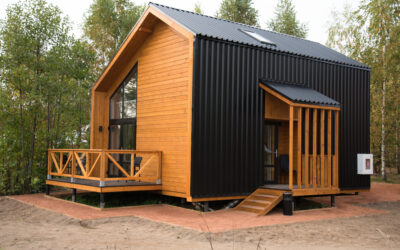What are the tax and investment considerations for a Granny Flat above versus a Tiny Home below? Income Tax Return Reporting - Income Streaming Tiny Homes Tiny home ownership does not have to follow the ownership interest of the underlying property ownership. For...
Homes with a Granny Flat, Tax Treatment?
January 30, 2022 Capital Gains, Property Advice, Property Taxation, Tax Planning

Granny flats and ancillary dwellings have grown in style and versatility becoming an increasingly popular housing option as they allow families to downsize closer to their family and friends, and provide extra space for older children and extended family. In addition, provide potential cashflow investment options now or in retirement, at an affordable price point, ROI, compared to a standalone separate property.
When you sell your home in the future, though it has been your principal place of residence (PPOR), your granny flat or ancillary dwelling may have had an investment focus, which will create tax issues at the time of sale.
Tax Treatment options?
- You first need to consider if there will be either a –
- Personal non-economic use, examples would include-
- Extended Family, friends, or student accommodations
- Investment use, examples would include –
- Privately or via an Agent, renting at the fair market rent
- Air Bnb host or the like
- Home Business use – hairdresser, massage therapist, etc
- Personal non-economic use, examples would include-
PERSONAL OR NON-ECONOMIC RENTAL USE
If the granny flat or ancillary dwelling was not used for assessable income-producing purposes (e.g., it was not rented at arms-length to the occupier – whoever that may be) then there will be no CGT on the sale of the main residence, provided it otherwise qualifies for the CGT main residence exemption.
This will be the case if the dwelling was not used for producing assessable income and if it qualified as the taxpayer’s main residence throughout the ownership period.

Mary & Jane purchased their (PPOR) and settled on the 1st July 2010, moved in immediately. Five years later Mary & Jane decided to build a Granny Flat for Mary’s aging parents, so they could spend more time together and help care for them. The Granny Flat was built in the backyard, representing 1/5th of the overall buildings, ready to occupy on the 1st of July 2015, when Mary’s parents moved in.
Five years later, Mary’s Parents needed extra care, so moved out into an aged care home, Mary & Jane then decided to also downsize and sell the PPOR, going under contract on the 1st of July 2020.
Prices in the area had increased substantially over the 10 years of living there, resulting in a capital gain of $500,000.

In this example there would be no Capital Gains Tax as the Granny Flat or ancillary dwelling would be treated as part of the PPOR, not being used to produce assessable income.
A SIMILAR OUTCOME IS RENTING OUT SPACE TO STUDENT ACCOMMODATIONS
Letting space in a granny flat or ancillary dwelling for student accommodation can be non-taxable, provided the rent only covers costs rather than making a profit. These arrangements are usually made through an educational institution for foreign students with the amount paid is set by the institution to cover food, laundry, transport, and other associated costs.
The ATO classifies these arrangements as “non-economic rentals”
INVESTMENT USE – PARTIAL EXEMPTION TO CGT
If on the other hand, instead of Mary’s parents moving into the Granny Flat or ancillary dwelling, the space was rented on the open market for fair market rent, or as an Airbnb host, capital gains would apply as follows:-
In this case, a partial exemption would apply under s 118-185 of the ITAA 1997 on the basis that the main residence was also used for income-producing purposes. The Granny Flat / Ancillary Dwelling is considered part or an extension of the PPOR.
Example
As with the previous example, the only difference, the space was rented for $300 per week from the 1st July 2015, and right up to the time of sale on the 1st July 2020.
What is the Capital Gains Tax (CGT)?
 The home other than the granny flat or ancillary dwelling was otherwise Mary & Jane’s PPOR for the 10 years.
The home other than the granny flat or ancillary dwelling was otherwise Mary & Jane’s PPOR for the 10 years.- The granny flat or ancillary dwelling was rented from the 5 years, the size of the space represented 1/5th of the overall home size
CGT FORMULA WOULD BE:-
Capital Gain * years rented / years owned * area not considered PPOR
$500,000 * 5yr/10yrs *1/5 = $50,000*#@
* 50% CGT discount would also apply,
# if used for small businesses, ie, hairdresser, massage therapist, etc, you may also qualify for small business CGT discounts under Div152 ITAA 1997

- Further 50% discount, 15-year CGT exemption, Retirement exemption, Roll-over concession, which can result in the a 100% exemption.
 @ Air Bnb Hosts may also qualify for the small business concessions, which will depend on if the Granny Flat is part of a portfolio of potential other properties, and or the complexity and regularity of bookings over time.
@ Air Bnb Hosts may also qualify for the small business concessions, which will depend on if the Granny Flat is part of a portfolio of potential other properties, and or the complexity and regularity of bookings over time.
WHAT IF, MARY & JANE MOVED INTO THE GRANNY FLAT / ANCILLARY DWELLING AND RENTED OUT THE MAIN HOME INSTEAD.
The same formula would apply with space being 4/5th instead of 1/5th.
WHAT IF MARY & JANE RENTED OUT THE WHOLE PPOR AND GRANNY FLAT?
If the whole property was rented out including the granny flat, Mary & Jane may have also been able to apply the 6 yr. absence rule S118-145 ITAA 1997 to the first 6 years of renting, provided no other home is nominated as their PPOR. In this case, the CGT would be: –
$500,000 * (6-6yrs) / 10yrs = $Nil
WHAT IF MARY & JANE WANT TO CLAIM ANOTHER HOME AS THEIR PPOR?
Mary & Jane could use the market value substitute rule S118-192 ITAA 1997 as of 1st July 2015 to uplift the cost base. If the capital gains were made mainly in the first 5 years, prior to renting, say, $400,000 of the $500,000. See also blog CGT renting PPOR
The capital gain would be $100,000 instead*
* also able to claim the 50% discount
This option would allow Mary & Jane to consider their new home purchase in 2015 to be their PPOR. This will depend on if Mary & Jane calculated that their new home would have much more substantial gains in the future, and hence CGT exempt, rather than a partial exemption.
IN SUMMARY

Over many years our homes can grow changing focus, providing for changing family sizes, extended families, while potentially also allowing investment options to help fund current lifestyles now and into retirement.
As you can see, the tax outcome will vary depending on the tax elections Mary & Jane make. There is a lot to consider besides any tax outcomes, however, we can help at least quantify any potential capital gains tax, so you can factor that into your overall planning.
If you would like any further advice, please contact our office or book online.

Fields marked with an * are required



